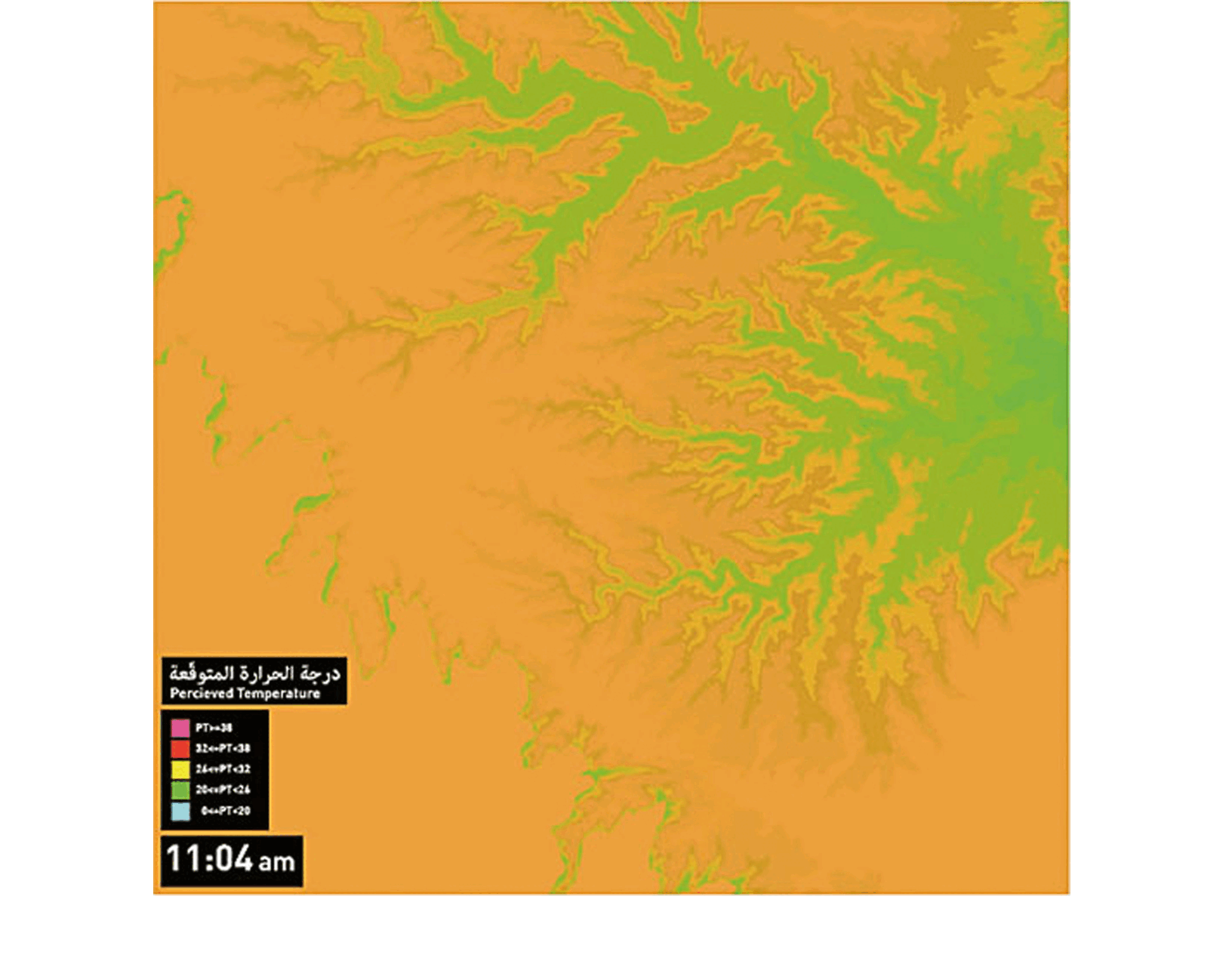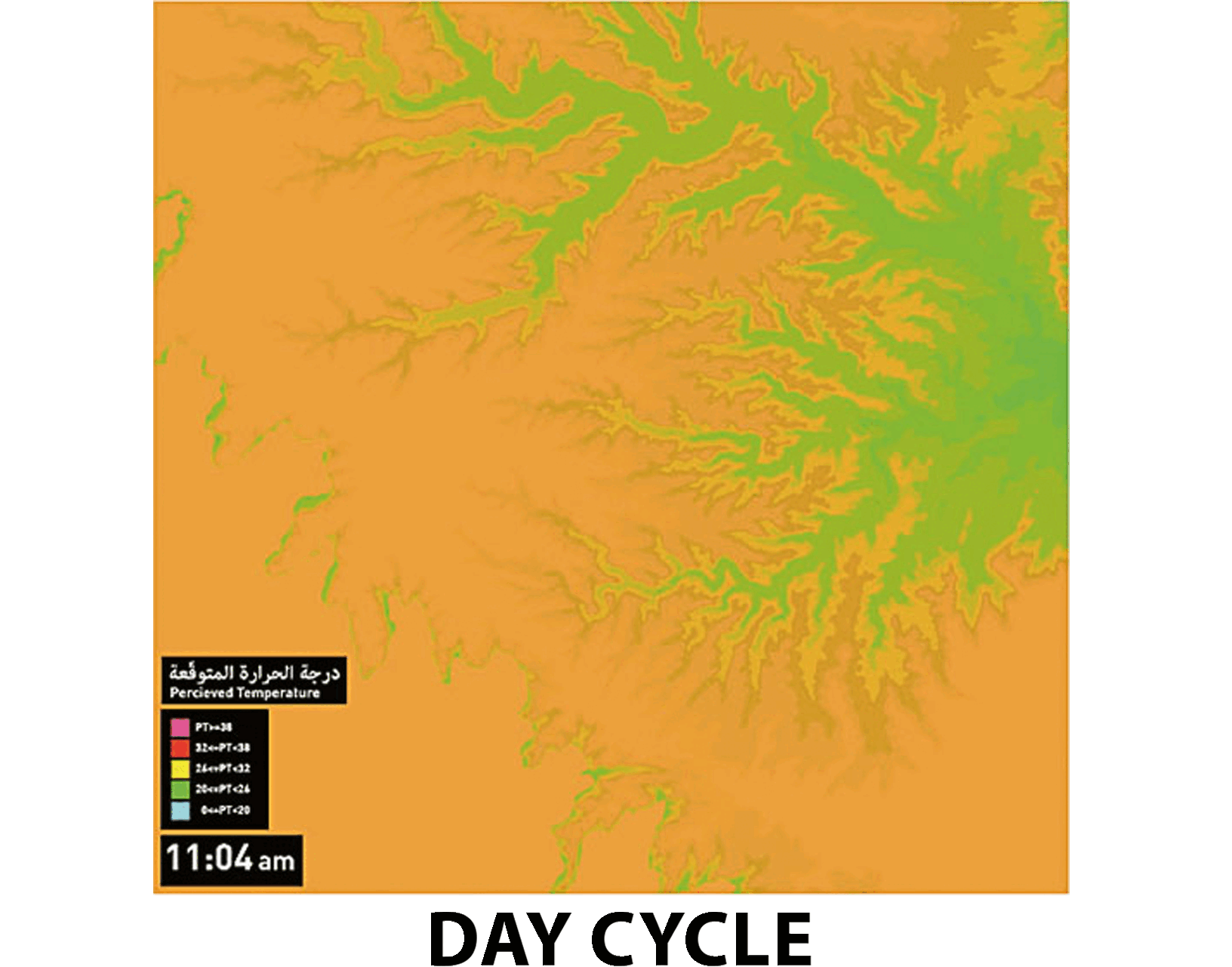A City of Clouds

Project
- K.A.CARE
Theme
- Future Cities
Size
- 888,335 m²
Lead
- Sebastian Schott
Team
- Kristof Gavrielides
- Stephan Albrecht
- Jarrod Lamshed
- Alexander Simon
- Rashmi Katkar
- Anh Dao Trinh
- Achim Kaufer
- Angela Ungarelli
- Jack Gillbanks
- Chang Liu
- Catherine Zhuang
- Matthew Austin
- Bum Suk Ko
- Richard Gomez
- Melanie Rieger
Images
- LAVA
- atelier illumine
Location
- Riyadh, KSA
Typology
- Master plan
Status
- Competition entry
Collaborators
- Media / Presentation: Jangled Nerves
- Climate Engineering: Transsolar
- Urban Growth: UCL / Space Syntax
- Innovation / Mobility: Fraunhofer IAO
- Engineering: Battle McCarthy
- Structure: Teuffel Consultants
- Bionics: Braun Associates
- Parametric Design: Aedas R&D
- Water: Dreiseitl
Year
- 2010
Client
- King Abdullah City for Atomic and Renewable Energy (K.A.CARE)
Partner
- Tobias Wallisser
- Alexander Rieck
- Chris Bosse
Recognitions
2013
Iconic Award
Project
- K.A.CARE
Location
- Riyadh, KSA
Year
- 2010
Typology
- Master plan
Theme
- Future Cities
Client
- King Abdullah City for Atomic and Renewable Energy (K.A.CARE)
Size
- 888,335 m²
Status
- Competition entry
Lead
- Sebastian Schott
Team
- Kristof Gavrielides
- Stephan Albrecht
- Jarrod Lamshed
- Alexander Simon
- Rashmi Katkar
- Anh Dao Trinh
- Achim Kaufer
- Angela Ungarelli
- Jack Gillbanks
- Chang Liu
- Catherine Zhuang
- Matthew Austin
- Bum Suk Ko
- Richard Gomez
- Melanie Rieger
Images
- LAVA
- atelier illumine
Collaborators
- Media / Presentation: Jangled Nerves
- Climate Engineering: Transsolar
- Urban Growth: UCL / Space Syntax
- Innovation / Mobility: Fraunhofer IAO
- Engineering: Battle McCarthy
- Structure: Teuffel Consultants
- Bionics: Braun Associates
- Parametric Design: Aedas R&D
- Water: Dreiseitl
Partner
- Tobias Wallisser
- Alexander Rieck
- Chris Bosse
Recognitions
2013
Iconic Award
What can urbanism learn from the clouds? For LAVA, this layer of lightweight infrastructure crucial to life on earth provides a template for imagining how a city could be connected by a multifaceted system that harvests energy, limits solar heat, manages water, conditions the climate, transmits information, and evolves how future desert cities can be inhabited.


CLOUD-BASED URBANISM
LAVA’s endeavors revolve around envisioning new horizons within unforgiving environments: Picture Saudi Arabia’s expansive deserts, rugged peaks, relentless winds, and blistering heat. Traditionally, architects confronted these challenges with air-conditioned skyscrapers and sprawling urban expanses on flat terrain, following structured radial or rectilinear growth patterns. Yet, the concept for K.A.CARE, The King Abdullah City for Atomic and Renewable Energy—a 6,500-hectare development for approximately 80,000 inhabitants near Riyadh—envisions how technology could inspire a new post-oil era in urban design, crafting a cloud-based infrastructure that enhances the lives of those dwelling in extreme climates.
This infrastructure is rooted in providing energy for K.A.CARE, where there is plenty of solar energy, yet water for living and food production is scarce. Following the principle of post-oil age—where the export of renewable energy sustains a cyclic economy based on optimized resource efficiency for water, food, and energy—the roofing of this ‘Cloud City’ is at the core of the city’s functioning. It provides a living laboratory where new technology defines the evolution of further roofing as the city expands.
“We conceptualized a city interconnected by a sophisticated cloudscape infrastructure harnessing renewable solar energy, conditioning the climate, managing water, and redefining the future of desert city living.”
Based on environmental research, the Cloud exists above a master plan based on the mountainous natural topography, giving rise to a decentralized system that reduces energy consumption and waste by harvesting closer to the source. “Combining learning from ancient cities with data from advanced tools like cloud modeling, the city becomes a flexible spatial structure capable of accommodating continuous growth while maintaining full functionality at the local level, resulting in an adaptive master plan process that anticipates the evolving needs of the cityscape,” explains LAVA Partner Alexander Rieck.



HOLISTIC THINKING
As a solar-powered public infrastructure, ‘The City of Clouds’ capitalizes on the untapped potential of outdoor public spaces to improve urban social sustainability, well-being, and health. Faced with extreme heat—where summer temperatures soar to 45 degrees Celsius—LAVA sought to leverage sunlight while mitigating its impact and establishing an outdoor microclimate reminiscent of Madrid or San Francisco.
“We delved into conditioning the outdoor environment and manipulating temperature levels without constructing additional buildings. The buildings would exist, yet we’re focusing on the spaces between them,” Rieck explains. Developing ideas from the ‘Sunflower Umbrellas’ of Masdar Plaza, the ‘City of Clouds’ consists of curvy tensile membrane structures that float above the city’s public spaces, employing bioremediation principles such as evaporative and slab cooling: “The structure provides outdoor environmental comfort, but its dynamism is a catalyst to diverse social experiences as a stage for a vibrant public life.”
"We analyzed ancient city systems to inform the growth strategy, utilizing parametric computer ‘cloud’ modeling for flexible, landscape-driven urban evolution."





CLOUD-SOURCED INFRASTRUCTURE
These clouds also become the substrate for the Internet of Things, enabling the whole city to communicate, from autonomous vehicles to pedestrians to robots. This vision of the future is unbound by cumbersome underground ducts full of fiber optic wires and clunky air management systems. Instead, a delicate, responsive infrastructure inspired by the cloud metaphor has been proposed. Rieck imagines the future vision: “This city of the future is bright, lightweight, and governed by this intelligent cloud system that holds information and becomes a metaphor for an inventive piece of infrastructure.”
Instead of viewing the desert terrain of Saudi Arabia as a barrier, it served as the cornerstone of the vision for K.A.CARE. Throughout LAVA’s projects, nature’s wisdom is embraced through the principles of biomimicry: emulating, echoing, and collaborating with nature rather than opposing it—a departure from the approach of many 20th-century cities, which classify and integrate nature into rigid grids.In this instance, the master plan for K.A.CARE, surrounded by the protected Tuwaiq uplands, was incorporated into the natural landscape, allowing the ‘wadis’—canyons carved out over millennia by natural processes—to influence the city’s layout. These natural features provide shelter from strong winds and dust, which can reduce visibility to under ten meters, and enable the architecture required for the microclimate created by the ‘City of Clouds’ to function effectively.


“We designed a master plan that is sunken into the mountainous desert terrain and oriented to provide shelter, utilize flood plains, and create an organic form supporting infrastructure and outdoor public life.”

“We defined a new type of infrastructure powered by solar energy for a new post-oil era modeled on the lightweight and functional properties of the clouds.”
POLYCENTRIC CITY
This approach offered numerous advantages, including the potential for an organically evolving polycentric city plan. When it comes to urbanism, mountainous topographies place a higher strain on infrastructure—as it must defy gravity, the movement of sewage and water is highly energy-consuming—a poly-nodal infrastructure mitigates this with resources traveling less distance and altitude. The canyon pathway connecting the nodes forms a central promenade of public buildings, retail, and public landscaped spaces at the bottom, creating a flood plain to collect rainwater which reaches 21 mm of rainfall a day during a storm: “When it rains, it pours,” remarks Rieck. “Leaving the valley’s center unobstructed for water management was crucial, yet concurrently allowed us to designate this land as public space contributing to an elevated urban experience and evolution of the traditional Arab city.”
The comprehensive vision of ‘The City of Clouds’ aimed to transform the urban lifestyle of its inhabitants in the desert through improved outdoor environmental comfort, social connections encouraged by nature and public space, and networked communications that expand the potential of the city as a living laboratory for new technologies and environmentally-conscious settlements. By giving form to the cloud metaphor, the urban methodology flows in tandem with existent ecosystems, emphasizing how nature and technology must pave the way to envision novel metropolitan futures for post-oil societies.
Our book What If (2022, Birkhäuser) features this project.





